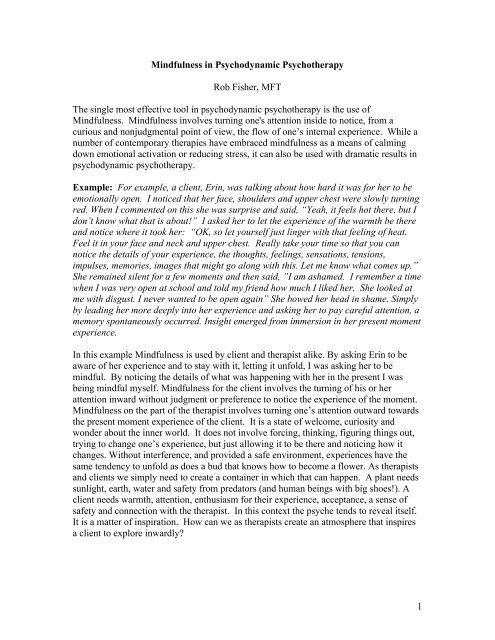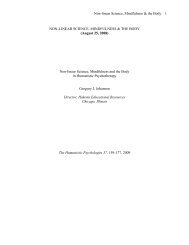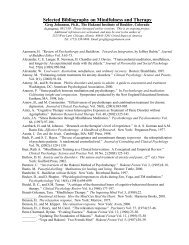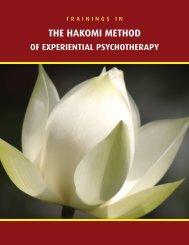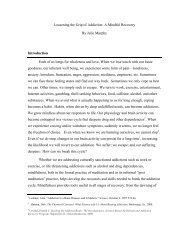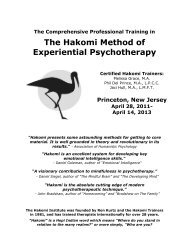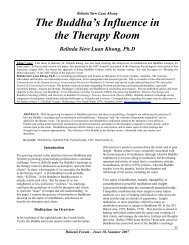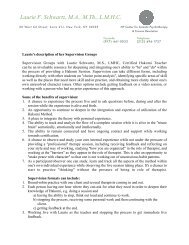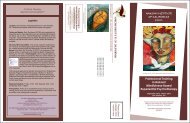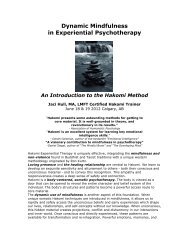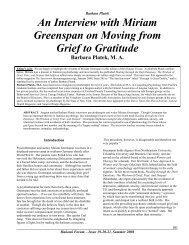1 Mindfulness in Psychodynamic Psychotherapy ... - Hakomi Institute
1 Mindfulness in Psychodynamic Psychotherapy ... - Hakomi Institute
1 Mindfulness in Psychodynamic Psychotherapy ... - Hakomi Institute
Create successful ePaper yourself
Turn your PDF publications into a flip-book with our unique Google optimized e-Paper software.
<strong>M<strong>in</strong>dfulness</strong> <strong>in</strong> <strong>Psychodynamic</strong> <strong>Psychotherapy</strong><br />
Rob Fisher, MFT<br />
The s<strong>in</strong>gle most effective tool <strong>in</strong> psychodynamic psychotherapy is the use of<br />
<strong>M<strong>in</strong>dfulness</strong>. <strong>M<strong>in</strong>dfulness</strong> <strong>in</strong>volves turn<strong>in</strong>g one's attention <strong>in</strong>side to notice, from a<br />
curious and nonjudgmental po<strong>in</strong>t of view, the flow of one’s <strong>in</strong>ternal experience. While a<br />
number of contemporary therapies have embraced m<strong>in</strong>dfulness as a means of calm<strong>in</strong>g<br />
down emotional activation or reduc<strong>in</strong>g stress, it can also be used with dramatic results <strong>in</strong><br />
psychodynamic psychotherapy.<br />
Example: For example, a client, Er<strong>in</strong>, was talk<strong>in</strong>g about how hard it was for her to be<br />
emotionally open. I noticed that her face, shoulders and upper chest were slowly turn<strong>in</strong>g<br />
red. When I commented on this she was surprise and said, “Yeah, it feels hot there, but I<br />
don’t know what that is about!” I asked her to let the experience of the warmth be there<br />
and notice where it took her: “OK, so let yourself just l<strong>in</strong>ger with that feel<strong>in</strong>g of heat.<br />
Feel it <strong>in</strong> your face and neck and upper chest. Really take your time so that you can<br />
notice the details of your experience, the thoughts, feel<strong>in</strong>gs, sensations, tensions,<br />
impulses, memories, images that might go along with this. Let me know what comes up.”<br />
She rema<strong>in</strong>ed silent for a few moments and then said, ”I am ashamed. I remember a time<br />
when I was very open at school and told my friend how much I liked her. She looked at<br />
me with disgust. I never wanted to be open aga<strong>in</strong>” She bowed her head <strong>in</strong> shame. Simply<br />
by lead<strong>in</strong>g her more deeply <strong>in</strong>to her experience and ask<strong>in</strong>g her to pay careful attention, a<br />
memory spontaneously occurred. Insight emerged from immersion <strong>in</strong> her present moment<br />
experience.<br />
In this example <strong>M<strong>in</strong>dfulness</strong> is used by client and therapist alike. By ask<strong>in</strong>g Er<strong>in</strong> to be<br />
aware of her experience and to stay with it, lett<strong>in</strong>g it unfold, I was ask<strong>in</strong>g her to be<br />
m<strong>in</strong>dful. By notic<strong>in</strong>g the details of what was happen<strong>in</strong>g with her <strong>in</strong> the present I was<br />
be<strong>in</strong>g m<strong>in</strong>dful myself. <strong>M<strong>in</strong>dfulness</strong> for the client <strong>in</strong>volves the turn<strong>in</strong>g of his or her<br />
attention <strong>in</strong>ward without judgment or preference to notice the experience of the moment.<br />
<strong>M<strong>in</strong>dfulness</strong> on the part of the therapist <strong>in</strong>volves turn<strong>in</strong>g one’s attention outward towards<br />
the present moment experience of the client. It is a state of welcome, curiosity and<br />
wonder about the <strong>in</strong>ner world. It does not <strong>in</strong>volve forc<strong>in</strong>g, th<strong>in</strong>k<strong>in</strong>g, figur<strong>in</strong>g th<strong>in</strong>gs out,<br />
try<strong>in</strong>g to change one’s experience, but just allow<strong>in</strong>g it to be there and notic<strong>in</strong>g how it<br />
changes. Without <strong>in</strong>terference, and provided a safe environment, experiences have the<br />
same tendency to unfold as does a bud that knows how to become a flower. As therapists<br />
and clients we simply need to create a conta<strong>in</strong>er <strong>in</strong> which that can happen. A plant needs<br />
sunlight, earth, water and safety from predators (and human be<strong>in</strong>gs with big shoes!). A<br />
client needs warmth, attention, enthusiasm for their experience, acceptance, a sense of<br />
safety and connection with the therapist. In this context the psyche tends to reveal itself.<br />
It is a matter of <strong>in</strong>spiration. How can we as therapists create an atmosphere that <strong>in</strong>spires<br />
a client to explore <strong>in</strong>wardly?<br />
1
<strong>M<strong>in</strong>dfulness</strong> is a primary tool that enables a direct connection between the client and<br />
her or his psyche.<br />
History: <strong>M<strong>in</strong>dfulness</strong> is, of course, borrowed from Buddhism where it is used as a<br />
method of meditation to help people to develop an <strong>in</strong>ternal place deeper than<br />
identification with their momentary experiences. Accord<strong>in</strong>g to Dharma Teacher Will<br />
Kabat-Z<strong>in</strong>n, MFTI, m<strong>in</strong>dfulness is used <strong>in</strong> Buddhism to explore what we are beneath our<br />
ideas and preconceptions about ourselves, a doorway to discover<strong>in</strong>g who we truly are.<br />
Susta<strong>in</strong>ed m<strong>in</strong>dfulness can lead <strong>in</strong>creas<strong>in</strong>gly to an <strong>in</strong>ternal freedom that is not dependent<br />
on any <strong>in</strong>ternal or external conditions. In psychodynamic psychotherapy we are more<br />
<strong>in</strong>terested <strong>in</strong> resolv<strong>in</strong>g the experiences themselves. Both applications are beneficial.<br />
In the 1980’s <strong>M<strong>in</strong>dfulness</strong> was applied to the realm of psychotherapy by Ron Kurtz who<br />
went on to found <strong>Hakomi</strong> Experiential Psychology which is now taught <strong>in</strong>ternationally.<br />
He now refers to his approach as “<strong>M<strong>in</strong>dfulness</strong> Assisted Self Study”. In the past few<br />
years it has been researched extensively and found to have a number of salutary effects<br />
such as decreas<strong>in</strong>g activity <strong>in</strong> the amygdala, reduc<strong>in</strong>g cortisone, <strong>in</strong>creas<strong>in</strong>g seroton<strong>in</strong> and<br />
melaton<strong>in</strong> levels and access<strong>in</strong>g material stored <strong>in</strong> implicit memory.<br />
In psychodynamic psychotherapy we can use it to explore the details of one’s experience<br />
“ <strong>in</strong> vivo” <strong>in</strong>stead of “<strong>in</strong> vitro”. The essence of many therapies is an attempt to change the<br />
client’s experience <strong>in</strong> relation to their self, the world and others – a rewir<strong>in</strong>g of the neural<br />
networks deeper than cognitive <strong>in</strong>sight can achieve. In psychoanalysis, the heart of<br />
therapy is experiential event - that is the exploration of the<br />
transference/countertransference relationship. It is not just the analysis and <strong>in</strong>terpretation<br />
of this relationship that causes change; it is the actual felt experience. Neural patterns<br />
change throughout our lives as a result of new experiences. While talk<strong>in</strong>g about events<br />
can help clients unburden themselves and reduce the sense of aloneness around them, we<br />
need to generate new experiences for long-term change to occur. <strong>M<strong>in</strong>dfulness</strong> orients the<br />
client around the experience of the moment as an entryway to core models of their world.<br />
When Jack left the office, stoop<strong>in</strong>g to avoid hitt<strong>in</strong>g his head on the doorframe, he shook<br />
my hand. A powerfully built man, his handshake offered me a set of limp f<strong>in</strong>gers that<br />
stood <strong>in</strong> sharp contrast to his otherwise impos<strong>in</strong>g physical structure. By pay<strong>in</strong>g attention<br />
to this little hologram of his presentation, and <strong>in</strong> a future session repeat<strong>in</strong>g it <strong>in</strong><br />
m<strong>in</strong>dfulness, his whole relationship to power became crystal clear. As he shook my hand<br />
I asked him to carefully study what he did and did not do with his hand and the<br />
accompany<strong>in</strong>g thoughts, feel<strong>in</strong>gs, images, memories, impulses, etc. He was <strong>in</strong>stantly clear<br />
how he had decided never to use his power aga<strong>in</strong> after beat<strong>in</strong>g up Jonnie Smith <strong>in</strong> 6 th<br />
grade. This decision, evident <strong>in</strong> his handshake, plagued his relationships ever s<strong>in</strong>ce. By<br />
explor<strong>in</strong>g the moment of the handshake carefully and slowly <strong>in</strong> m<strong>in</strong>dfulness he was able<br />
to become aware of his relationship with power and beg<strong>in</strong> to experiment with new beliefs<br />
and behaviors start<strong>in</strong>g with me.<br />
Assessment: <strong>M<strong>in</strong>dfulness</strong> can also be used for assessment. To assess what is happen<strong>in</strong>g<br />
<strong>in</strong> a client’s <strong>in</strong>ternal world, one needs details before theories. From details hypothesis<br />
2
can be generated. Most of communication between client and therapist is not verbal.<br />
When a client comes <strong>in</strong> with a slow gait and sits down with a sigh, she is communicat<strong>in</strong>g<br />
to us, not <strong>in</strong> the language of words, which can be easily disguised, but <strong>in</strong> the language of<br />
experience. The unconscious speaks <strong>in</strong> many languages (Ron Kurtz <strong>in</strong> private<br />
conversation). It is important that we hear it. By notic<strong>in</strong>g <strong>in</strong> any moment, not only the<br />
content of what is be<strong>in</strong>g said, but what the client is do<strong>in</strong>g, how they are do<strong>in</strong>g it and what,<br />
at any given moment they are experienc<strong>in</strong>g, we add a dimension to therapy that results <strong>in</strong><br />
a journey <strong>in</strong>to the depths, not just of the neo-cortex, but <strong>in</strong>to deeper parts of the bra<strong>in</strong><br />
where more fundamental issues are available.<br />
There is a limit to the effectiveness of conversation <strong>in</strong> psychotherapy.<br />
<strong>M<strong>in</strong>dfulness</strong> <strong>in</strong> <strong>Psychodynamic</strong> Interventions: How then is m<strong>in</strong>dfulness actually used<br />
<strong>in</strong> therapy? Here is an example with a couple: Jon and Karen had a terrible fight that led<br />
them to therapy. She compla<strong>in</strong>ed about him, “Whenever I want he says, ‘No’. I ask him<br />
to go to lunch, he says ‘No’. I ask him to go to the movies, he says no. I ask him to make<br />
love, he says no.” I have had it!” While I could have reflected back the content of what<br />
she had just said, I reflected back her present experience, “That’s really frustrat<strong>in</strong>g,<br />
huh?” Smart therapist that I am, I had a pretty good idea of what was go<strong>in</strong>g wrong here:<br />
she was probably ask<strong>in</strong>g <strong>in</strong> an alienat<strong>in</strong>g way. Follow<strong>in</strong>g my own lead, I thought I would<br />
test my hypothesis. “So go ahead and ask him for someth<strong>in</strong>g right now and lets see what<br />
happens”.<br />
One can obta<strong>in</strong> much more <strong>in</strong>formation<br />
from the present<br />
than the past.<br />
Contrary to my idea, however she was sweet and <strong>in</strong>vit<strong>in</strong>g <strong>in</strong> her presentation. I still knew<br />
better, of course. I was sure that at home she was not on such good behavior. Then I<br />
looked at him. He said, “See, she is always try<strong>in</strong>g to push me around!” Clearly he<br />
experienced her offer as coercion. My hypothesis was wrong, but I had at least checked<br />
it out experientially <strong>in</strong>stead of rely<strong>in</strong>g on my misplaced <strong>in</strong>terpretation. Appropriately<br />
chastened, I asked them to repeat the <strong>in</strong>teraction <strong>in</strong> m<strong>in</strong>dfulness. “So, lets try that aga<strong>in</strong>,<br />
Karen, why don’t you just say one sentence aga<strong>in</strong> ask<strong>in</strong>g him to go out to a restaurant,<br />
and Jon, notice what ever comes up hear<strong>in</strong>g her. There may be that feel<strong>in</strong>g of be<strong>in</strong>g<br />
pushed, there may be images or memories, sensations <strong>in</strong> your body, anyth<strong>in</strong>g even if its<br />
not l<strong>in</strong>ear. Let me know. Let her know when you are ready and she will say it to you<br />
aga<strong>in</strong>.” This time he studied his experience <strong>in</strong>stead of just react<strong>in</strong>g. <strong>M<strong>in</strong>dfulness</strong><br />
assisted self-study. He noticed that he was hav<strong>in</strong>g images of all the people who had<br />
pushed him around <strong>in</strong> his life, from his parents to the Bible to the mult<strong>in</strong>ational<br />
corporations. He was fight<strong>in</strong>g all of them. The good news was that when he refused to<br />
make love with her, it was not just her <strong>in</strong> bed with him, it was all the people whom he felt<br />
had controlled his life. By ask<strong>in</strong>g for m<strong>in</strong>dfulness, much material became available that<br />
was not readily accessible <strong>in</strong> ord<strong>in</strong>ary conversation.<br />
3
Protocol: Here is a brief protocol for us<strong>in</strong>g m<strong>in</strong>dfulness psychodynamically.<br />
§<br />
§<br />
§<br />
§<br />
§<br />
§<br />
§<br />
§<br />
§<br />
The therapist must be aware of what is happen<strong>in</strong>g <strong>in</strong> the present <strong>in</strong> addition to<br />
content. This <strong>in</strong>cludes notic<strong>in</strong>g the immediate actions of the client, her or his<br />
style of do<strong>in</strong>g, and his or her moment-to-moment experience.<br />
It is also important for the therapist to notice the details of his or her own <strong>in</strong>ternal<br />
experience moment to moment (countertransference).<br />
The client can be asked to study any element of their experience <strong>in</strong> m<strong>in</strong>dfulness<br />
by say<strong>in</strong>g the follow<strong>in</strong>g. It is best to select an element that is of <strong>in</strong>terest to the<br />
client and <strong>in</strong> l<strong>in</strong>e with the theme of the session:<br />
o “Lets take a moment to really explore that. Would that be OK?”(Ask<strong>in</strong>g<br />
permission)<br />
o “Let your attention go <strong>in</strong>side so that you can notice the details of your<br />
experience.” (Orient<strong>in</strong>g <strong>in</strong>wardly)<br />
o “Notice the thoughts, feel<strong>in</strong>gs, sensations, images, memories, tensions,<br />
relaxation, changes <strong>in</strong> breath<strong>in</strong>g, impulses that occur as you pay<br />
attention.” (Provid<strong>in</strong>g a menu of possibilities frees clients from the usual<br />
limitation of look<strong>in</strong>g for either thoughts or feel<strong>in</strong>gs. Internal experience is<br />
quite multidimensional. Stay away from emphasiz<strong>in</strong>g only feel<strong>in</strong>gs and<br />
thoughts.)<br />
“Noth<strong>in</strong>g has to happen”. (Take the pressure off. People generally try too hard.<br />
This <strong>in</strong>terferes.)<br />
Wait and wonder. (Your <strong>in</strong>ternal state is crucial here. It is important that you<br />
slow down you r <strong>in</strong>ternal pace. This can limbically affect your client who will<br />
follow you <strong>in</strong>side.)<br />
It is also important that you are curious and enthusiastic about their experience.<br />
(While you do not need to put on a m<strong>in</strong>iskirt and wave pom-poms, your <strong>in</strong>terest <strong>in</strong><br />
what happens can be <strong>in</strong>spir<strong>in</strong>g to them. If you try to be neutral, you de-humanize<br />
the relationship. I realize that is a controversial. You can test this out by try<strong>in</strong>g to<br />
<strong>in</strong>teract neutrally or with enthusiasm and warmth and note the results. Clients are<br />
track<strong>in</strong>g us like hawks, and are tak<strong>in</strong>g <strong>in</strong> tremendous amounts of <strong>in</strong>formation<br />
about us whether we try to be neutral or not.)<br />
Notice what you can tell about their new present moment experience from the<br />
outside and ask for a report as well.<br />
Connect with them on this level. By reflect<strong>in</strong>g back, not just content, but their<br />
experience, you will deepen the relationship and the therapy exponentially.<br />
Examples of this might be, “You’re sad, huh?” Everyth<strong>in</strong>g just got still”, “You<br />
just tensed up a bit, huh?” Unless you want to engage the neocortex, keep your<br />
sentences short and simple.<br />
Ask them to stay with their experience and let it unfold to the next experience.<br />
For example, Jane was disconcerted that her excitement about buy<strong>in</strong>g a new car<br />
seemed clouded. As she stayed with her experience of excitement mixed with<br />
someth<strong>in</strong>g else emotionally darker, what was unclear started to take form. By<br />
stay<strong>in</strong>g with the experience of the dark spot, she became clear that her European<br />
parents would have looked down on her choice of an American car. By then<br />
4
stay<strong>in</strong>g with the image of her parents’ disapproval, she began naturally to<br />
sympathetically feel their hardship as immigrants. Allow<strong>in</strong>g herself to stay with<br />
this feel<strong>in</strong>g led her to a sense of herself as be<strong>in</strong>g separate from their values and<br />
more connected to herself.<br />
Conclusion: Through the use of m<strong>in</strong>dfulness <strong>in</strong> psychodynamic psychotherapy a number<br />
of important therapeutic elements become immediately available. It encourages people to<br />
“act <strong>in</strong> “ <strong>in</strong>stead of “act<strong>in</strong>g out Exponentially more <strong>in</strong>formation becomes available <strong>in</strong><br />
m<strong>in</strong>dfulness than <strong>in</strong> ord<strong>in</strong>ary conversation.<br />
It is empower<strong>in</strong>g for a client explore their own experience as opposed to rely<strong>in</strong>g on a<br />
therapist to expla<strong>in</strong> what is happen<strong>in</strong>g <strong>in</strong>side. It helps people become more connected<br />
with themselves. It takes therapy to a new depth that goes beyond the cognitive <strong>in</strong>to the<br />
experiential. The difference between m<strong>in</strong>dful exploration <strong>in</strong> therapy and conversation is<br />
the difference between wolf<strong>in</strong>g down a Big Mac and fries while driv<strong>in</strong>g to your office vs.<br />
sitt<strong>in</strong>g comfortably <strong>in</strong> a French restaurant where you are served on small portion of a<br />
f<strong>in</strong>ely prepared dish. You sit and savor every morsel, notic<strong>in</strong>g how the rosemary mixes<br />
with the garlic <strong>in</strong> the entree, and the particular confluence of raspberry and chocolate <strong>in</strong><br />
the warm, fragrant desert. One simply notices more <strong>in</strong> this state. One notices the<br />
substrata of the psyche. (Analogy courtesy of Kathleen Dunbar, MFT.)<br />
How would you like to conduct therapy?<br />
Rob Fisher is an MFT and tra<strong>in</strong><strong>in</strong>g consultant <strong>in</strong> private practice<br />
<strong>in</strong> Mill Valley where he specializes <strong>in</strong> tra<strong>in</strong><strong>in</strong>g other therapists <strong>in</strong><br />
work<strong>in</strong>g with the present moment. He is the author of numerous<br />
articles and book chapters, and the book Experiential<br />
<strong>Psychotherapy</strong> with Couple – a Guide for the Creative Pragmatist<br />
(Zeig/Tucker 2002). He teaches at JFK University and CIIS where<br />
he is the Co-Developer and Lead Instructor of the <strong>M<strong>in</strong>dfulness</strong> and<br />
Compassion Certificate Program for Psychotherapists. He is a<br />
<strong>Hakomi</strong> Tra<strong>in</strong>er who teaches tra<strong>in</strong><strong>in</strong>gs <strong>in</strong> m<strong>in</strong>dfulness based<br />
psychodynamic psychotherapy <strong>in</strong>ternationally for the <strong>Hakomi</strong><br />
<strong>Institute</strong>, and frequently through the <strong>Hakomi</strong> <strong>Institute</strong> of California which provides<br />
tra<strong>in</strong><strong>in</strong>gs <strong>in</strong> therapeutic skills <strong>in</strong> locations throughout California. He appears at national<br />
conferences such as the <strong>Psychotherapy</strong> Networker Conference, the USABP Conference,<br />
and has been a master presenter at annual CAMFT Conferences. More <strong>in</strong>formation about<br />
him is available through, or www.hakomicalifornia.org. He can be contacted at<br />
wildtemple@aol.com.<br />
This article appeared <strong>in</strong> the September/October 2011 issue of The Therapist, the publication of the<br />
California Association of Marriage and Family Therapists (CAMFT), headquartered <strong>in</strong> San Diego,<br />
California. This article is copyrighted and been repr<strong>in</strong>ted with the permission of CAMFT. For more<br />
<strong>in</strong>formation regard<strong>in</strong>g CAMFT, please log on to www.camft.org.<br />
5


